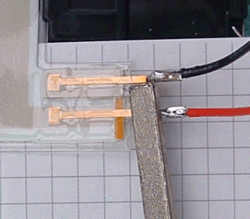|
 Cut the contacts so that about
5 mm (0.2 inches) remain, i. e. a little shorter than what you see in the picture. Cut the contacts so that about
5 mm (0.2 inches) remain, i. e. a little shorter than what you see in the picture.
Now comes the most crucial step. If the contacts get too hot, the foil will melt
and the backlight will be destroyed. Whatever happens, do not apply heat for more than half a second at a time. If you canít solder the wire to its contact in
half a second, wait a minute and try again. If you have a soldering station that allows temperature adjustment, use the lowest temperature that will still melt
the tin. Tin the contacts. Keep the tin on the wire melted while moving the wire towards the contact. Be aware that the wireís insulation is not going to
withstand heat forever, either, so donít take too much time doing that. Remove the soldering tip as soon as the soldering joint looks good. Using a pair of
soldering clamp tweezers (the ďinverseĒ type that stays closed and must be pushed to open them) is an excellent way to get rid of unwanted heat.
Polarity, by the way, does not matter here because the backlight foil feeds on AC current. Then again, it wonít hurt to solder the wires back on the way they were. |

